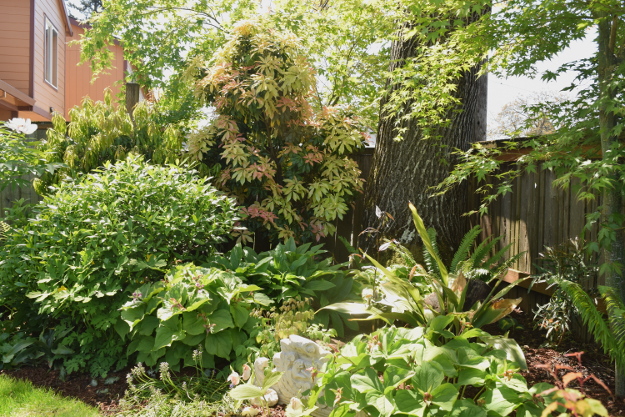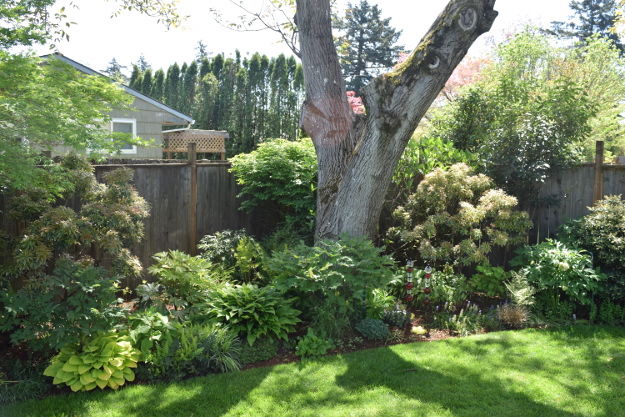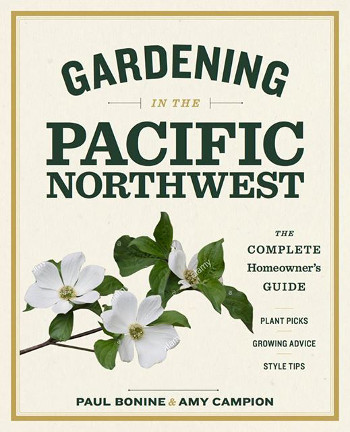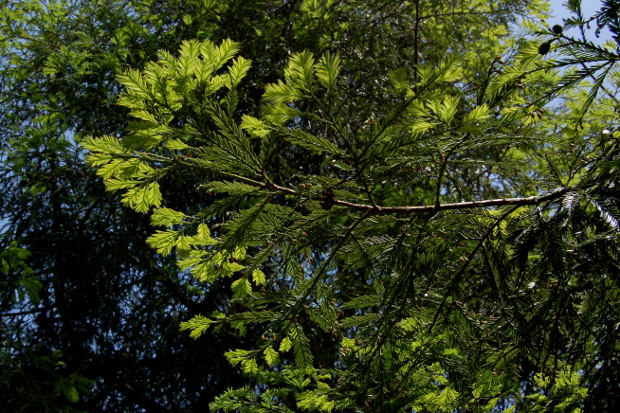
While many gardeners have been sprinkling coffee grounds, brewing compost tea, and painting pruning cuts, Dr. Linda Chalker-Scott has been busy destroying gardening myths like these. One by one, the fiery University of Washington Associate Professor and Extension Horticulturist has been debunking gardening beliefs and practices that don’t hold up to scientific scrutiny. Most recently, she has taken aim at a belief that has rooted in like bindweed: the notion that chemicals in walnut trees stunt and kill nearby plants. A paper Chalker-Scott published earlier this year asserts that, in reality, the killer walnut tree theory has little basis in fact.
I say “little basis” rather than no basis. Her exhaustive study of the literature did turn up experiments that revealed a kernel of truth to the idea. In the lab, when juglone (a chemical produced by walnut trees) was applied to germinating seeds and seedlings, the result was indeed “stunting, wilting, and necrosis” of the young plants. However, in the field, this phenomenon (known as allelopathy, which translates to “death to others”) has never been observed in a legitimate scientific experiment. Researchers have concluded that, in the landscape, most of the juglone in the rootzone of a walnut tree is soon broken down by microorganisms in the soil, or it becomes tightly bound to clay particles. It basically disappears.
Traditional wisdom also holds that walnut tree mulch is suspect. Many believe that toxic chemicals in walnut wood chips suppress plant growth. Chalker-Scott addresses this concern, too, pointing out that virtually no hydrojuglone (which becomes juglone in the soil) is present in the wood of the walnut tree. It is mostly in the roots and hulls. She advises gardeners, “Use walnut wood chips for mulch if you have them. They will not harm plants and work just as well as those from any other woody species.” (If you’re aware of her work, you know that Linda Chalker-Scott is a BIG fan of wood-chip mulch.)

When promoting the idea of the toxic walnut tree, gardening experts sometimes cite personal observations of the phenomenon, but without scientific controls, who’s to say it wasn’t merely root competition or too much shade or some other factor that made their plants struggle? Competition for water and nutrients is fierce under a mature walnut tree.
In advocating for caution around walnuts, other authorities, Chalker-Scott says, cite one of two Extension publications. This is where it gets really interesting. The first article, from Ohio State University (Funt and Martin 1993), was pulled from the Ohio State website for being out of date. You cannot find it anywhere and read for yourself the claims it makes. The other one, from Cornell (Crist and Sherf 1973), is nowhere to be found either, and as far as one Cornell librarian can tell, it never existed at all! The original citation of it was simply a mistake, and no one bothered to verify it.
Dr. Chalker-Scott’s “Do Black Walnut Trees Have Allelopathic Effects on Other Plants?” was published in March of this year. I had hoped that by now, word would have gotten out and garden gurus would have changed their tune. Alas, a quick internet search for “Extension walnut toxicity” reveals the same regurgitated warnings, the same lists of “tolerant” and “sensitive” plants. A partial list of Extension sites still promoting this dubious message includes:
Penn State
University of Wisconsin
Kansas State
Iowa State
Purdue
Michigan State
University of Delaware
Virginia Tech
University of Illinois
University of Nebraska
University of Missouri
University of New Hampshire
Kudos, though, to the University of Maryland! It cites Dr. Chalker-Scott’s paper and concurs with her results.

Now, is Linda Chalker-Scott’s paper the last word on walnut toxicity? No, that’s not how science works. Many questions remain, and hopefully future research will shed light on these questions and improve our understanding of the subject. One thing I wonder about is all of those anecdotal observations of plants dying under walnut trees. Could there be some truth to the stories after all? Maybe future studies will show that there are some situations in which it does happen.
Another thing I’m curious about is the plant’s manufacture of hydrojuglone/juglone. If it isn’t effective in killing competitors in the landscape, then why does the tree produce it? Isn’t there a cost (an investment of energy and resources) to the tree in producing this chemical? Is the tree in the process of evolving a more effective version of juglone? Or, was juglone more effective at one time, but microorganisms have evolved to remove it from the soil so that it doesn’t affect the plants they rely on? Or, is the toxicity of juglone merely a side-effect? Perhaps the chemical serves some other purpose for the tree.
We don’t yet know the whole story, but in the meantime, please, gardeners and horticultural professionals, let’s stop spreading misinformation and hearsay.




























Thanks, Amy, for helping to dispel the misinformation about walnut trees. The local squirrels continuously plant black walnuts in our garden. Now, I don’t have to worry about chemical reactions from juglone. I will still pull the starts because our garden provides no place for such a massive tree.
Let’s get the word out!
Very interesting post, Amy.
I have been intrigued by allelopathy as a topic for some time. My understanding is that certain plants affect other very specific plants – not necessarily all plants. I know I planted a raspberry too close to a potato once and the raspberry immediately began to die, while another planted several feet farther away was just fine. Was it really the potato? I can’t say for sure, but it was the most likely suspect. Apparently, potatoes can be allelopathic to certain plants, too. There’s a lot of interesting conversations and snubbing going on underground!
There appears to be some evidence of allelopathy in sweet potatoes, but I don’t see anything on regular potatoes.
Interesting. I have to say, my favorite line is this: “No, that’s not how science works.” Seems the nation, indeed the whole world, could do with hearing your message.
Cheers Ms. Amy
Amen. Though once there are a lot of studies saying the same thing, we can reasonably accept certain things as true.
I wonder if the primary function of juglone, that makes it evolutionarily worthwhile for the walnut to produce it, is to stunt/kill/discourage young walnuts from growing within the root zone. Despite the squirrels’ best efforts, there are always some nuts left lying right around the tree, yet no new walnut sprouts appear there. Elsewhere, nuts buried shallowly or deeply sprout right on schedule…
That is a really good hypothesis!
In the gardens at Joy Creek Nursery there are a few large old English walnuts that came with the property when Mike bought it. They are all underplanted with a variety of plant material and all do well. Customers and visitors are often baffled by this – how can it be? Thanks for the article Amy – this might help to explain how it could be that we have a jungle of plants growing happily under these giants.
Oh, yeah! I forgot about that. No shortage of underplantings there. Linda didn’t mention any kind of walnut besides black walnut, so I wondered if it was the same story. Probably.
I have a large English walnut in the middle of a garden area I am renovating, so I’ve been looking into this. According to some sources, because English walnuts have a much lower level of juglone than black walnuts, they don’t affect the growth of other plants. I’m glad you reminded me about the walnuts at Joy Creek, I’ll be sure to check out the under plantings during my next visit for ideas.
Great post and thank you for featuring my trees! When I started my garden, I worried about planting under the walnut trees and I was pretty fastidious about cleaning up the catkins, nuts/hulls, and leaves. But after 13 years, I have never had anything languish or die under them, so I’m no longer worried.
Thank you for letting me take photos of your garden. It is AMAZING!!
vary good post.
This is copied from one of Dr. Chalker-Scott’s publications, which I accessed through her website:
“There are bona-fide examples of allelopathy in tree species. Probably the best known is black walnut (Juglans nigra), which contains the compound juglone. This water-solube member of the quinone family is found in all parts of the black walnut and is quite effective in killing competitors, especially seedlings and other shallowly-rooted plants. It appears that juglone reduces oxygen uptake and photosynthetic activity, inhibiting growth of sensitive plants. Nevertheless, there are a variety of landscape plant materials that are resistant to juglone toxicity.”
So are you correct that Dr. Chalker-Scott asserts that, in reality, the killer walnut tree theory has little basis in fact? I’d say you’re mischaracterizing what she actually does say.
Elwyn, that is an old white paper I published years ago. The peer-reviewed publication Amy cites here is the current science on the topic. Science evolves, so a smart Extension specialist evolves along with it.
I have a volunteer black walnut growing in my asparagus. The asparagus is ‘volunteer’ around what was the midden of kitchen/ garden scrap that was dumped beside the outhouse until 1952 when the plumbing was installed. The midden probably was used for another 15 tears.
The asparagus used to be 6+ feet tall with stalks 2” diameter. I assume there is shade and nutrient competition as the asparagus is moving to the drip line but is suddenly only 1/4 “ diameter.
Would an enlargement of the bed with a heavy top dressing of composted manure moving out from the base of the tree feed the tree taking the stress off the asparagus improve the yield?
Would the elimination of the walnut tree allow reestablishment of the asparagus?
This year the asparagus is setting berries in a profusion I have not seen before. Is this a sign of stress and is our skinny asparagus just the establishment of a new generation of plants as the old dies out?
I picked asparagus for 30 years and have laid off for the past four years. I top dress with high carbon, low nitrogen after weeding, hoping the worms rise to condition the root mat. I will be adding mushroom compost anyway, but should I remove the walnut (4” bole, well elevated), and how long would any juglan last if this is a problem?
Hello ! Thank warmly for this article ,which soothed greatly my worry about the so-called harmful side of walnut trees. I have sown in my garden in Bulgaria ,Europe a common walnut( Juglans Regia) and an Aleppo Pine (pinus halepensis) with a free ground of 4 meters between them. I began to greatly worry if after time when the two trees grow big and then their crown and branches meet ,the leaves of walnut tree will began to harm and kill the aleppo pine? But ,anyway ,I will not shift the stead of the walnut trees or the pine tree and they shall nearby each other and the time will show whether the walnut will harm the pine tree.
P.s.They shall stand nearby each other for ever or until the one tree harm and kill the other tree.(I do strongly hope that this will never happen).
[…] put up The Myth of the Killer Walnut Tree first appeared on The World’s Best Gardening […]